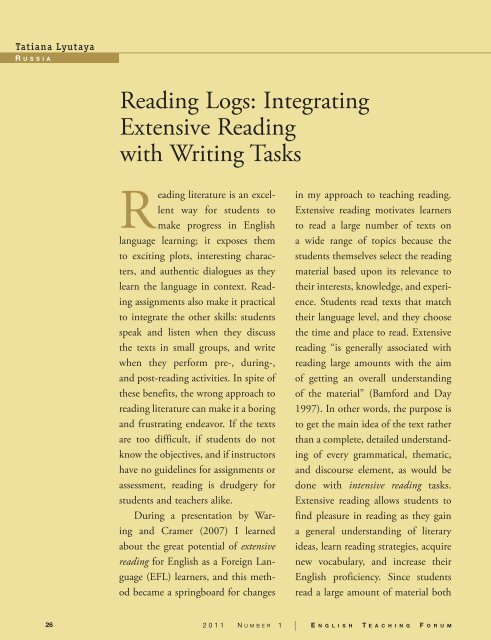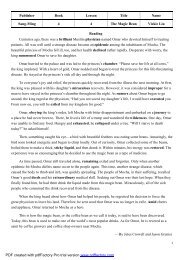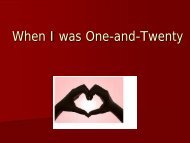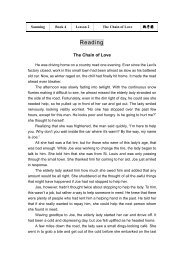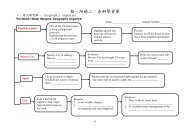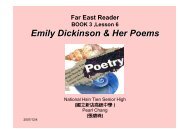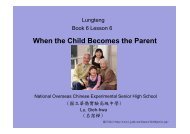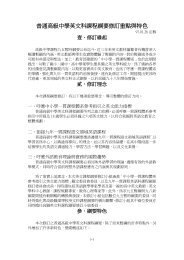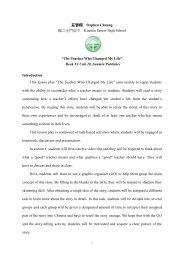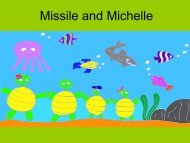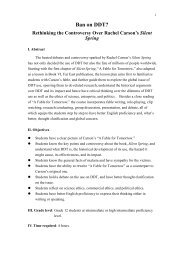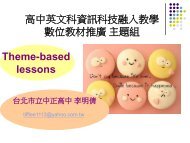Reading Logs: Integrating Extensive Reading ... - American English
Reading Logs: Integrating Extensive Reading ... - American English
Reading Logs: Integrating Extensive Reading ... - American English
You also want an ePaper? Increase the reach of your titles
YUMPU automatically turns print PDFs into web optimized ePapers that Google loves.
Ta t i a n a Ly u t aya<br />
<strong>Reading</strong> <strong>Logs</strong>: <strong>Integrating</strong><br />
<strong>Extensive</strong> <strong>Reading</strong><br />
with Writing Tasks<br />
<strong>Reading</strong> literature is an excellent<br />
way for students to<br />
make progress in <strong>English</strong><br />
language learning; it exposes them<br />
to exciting plots, interesting characters,<br />
and authentic dialogues as they<br />
learn the language in context. <strong>Reading</strong><br />
assignments also make it practical<br />
to integrate the other skills: students<br />
speak and listen when they discuss<br />
the texts in small groups, and write<br />
when they perform pre-, during-,<br />
and post-reading activities. In spite of<br />
these benefits, the wrong approach to<br />
reading literature can make it a boring<br />
and frustrating endeavor. If the texts<br />
are too difficult, if students do not<br />
know the objectives, and if instructors<br />
have no guidelines for assignments or<br />
assessment, reading is drudgery for<br />
students and teachers alike.<br />
During a presentation by Waring<br />
and Cramer (2007) I learned<br />
about the great potential of extensive<br />
reading for <strong>English</strong> as a Foreign Language<br />
(EFL) learners, and this method<br />
became a springboard for changes<br />
in my approach to teaching reading.<br />
<strong>Extensive</strong> reading motivates learners<br />
to read a large number of texts on<br />
a wide range of topics because the<br />
students themselves select the reading<br />
material based upon its relevance to<br />
their interests, knowledge, and experience.<br />
Students read texts that match<br />
their language level, and they choose<br />
the time and place to read. <strong>Extensive</strong><br />
reading “is generally associated with<br />
reading large amounts with the aim<br />
of getting an overall understanding<br />
of the material” (Bamford and Day<br />
1997). In other words, the purpose is<br />
to get the main idea of the text rather<br />
than a complete, detailed understanding<br />
of every grammatical, thematic,<br />
and discourse element, as would be<br />
done with intensive reading tasks.<br />
<strong>Extensive</strong> reading allows students to<br />
find pleasure in reading as they gain<br />
a general understanding of literary<br />
ideas, learn reading strategies, acquire<br />
new vocabulary, and increase their<br />
<strong>English</strong> proficiency. Since students<br />
read a large amount of material both<br />
26 2 0 1 1 N UMBER 1 | E N G L I S H T E A C H I N G F O R U M
inside and outside of the classroom, it is<br />
important for the teacher to make the objectives<br />
clear and properly monitor the students’<br />
progress. This includes knowing how to make<br />
reading interesting for students and also what<br />
assignments and assessment procedures contribute<br />
to a successful reading project.<br />
This article will discuss the rationale for<br />
using extensive reading of literary texts in the<br />
EFL classroom and describe how to integrate<br />
writing tasks with a reading project by using a<br />
reading log (also known as a reading journal, a<br />
response journal, or a reading diary) for pre-,<br />
during-, and post-reading activities. Finally,<br />
I will describe assessment procedures for the<br />
combined reading and writing tasks.<br />
Benefits of extensive reading<br />
Effective reading skills are especially vital<br />
in the EFL context because exposure to spoken<br />
<strong>English</strong> is scanty, and reading is very often<br />
the only source of comprehensible and meaningful<br />
linguistic input that helps unconscious<br />
acquisition of the language (Krashen 1981).<br />
In addition to decoding sounds, words, and<br />
sentences, reading requires upper-level thinking<br />
skills and social awareness (Burns 2003).<br />
As they confront new ideas, readers use their<br />
background knowledge and experiences to<br />
construct meaning and form opinions about<br />
problems that derive from the text. For those<br />
who want to be creators and independent<br />
thinkers, literacy goes well beyond simply<br />
knowing how to read and write. In both the<br />
native and foreign language, critical literacy<br />
requires more than passively absorbing what<br />
is on the printed page; “it requires attaining a<br />
deep understanding of what is read, remembering<br />
important information, linking newly<br />
learned information to existing schemata,<br />
knowing when and where to use that information,<br />
using it appropriately in varied contexts<br />
in and out of school, and communicating<br />
effectively with others” (Graves, Juel, and<br />
Graves 2000, 24).<br />
Over the years, numerous studies have<br />
reported that extensive reading benefits language<br />
learners in a variety of ways, including<br />
in the area of critical literacy. These studies<br />
claim that prolific readers noticeably improve<br />
their reading proficiency, reading habits, reading<br />
fluency, and vocabulary retention, as<br />
well as writing and spelling (Nation 1997).<br />
In addition to gains in a range of language<br />
skills, students experience delight in language<br />
learning and positive feelings as extensive<br />
reading motivates them for further study and<br />
reading. Gee (1999) argues that the more we<br />
read, the more competent language learners<br />
we become, and the more we enjoy reading;<br />
the more we enjoy it, the more we read,<br />
and the more competent language learners<br />
we become. This cycle consolidates language<br />
learning in other important ways as well: we<br />
gain more competence in the target culture<br />
and acquire broader background knowledge<br />
for more complex reading.<br />
When students read in a foreign language,<br />
there is often a tendency to focus more on<br />
new words or structures than on content or<br />
opinions (Freebody and Luke 1990). This<br />
happens not because the readers are incapable<br />
of reading for content due to their limited<br />
knowledge of the target language, but because<br />
they very often do not know how to make<br />
reading more meaningful. For example, language<br />
learners should know that numerous<br />
strategies are available to obtain information<br />
from the text as well as to get aesthetic<br />
pleasure out of reading. For this reason, I<br />
designed a project in which extensive reading<br />
goes hand in hand with writing activities. My<br />
main concerns were to arouse students’ interest<br />
in reading literature in <strong>English</strong> (novels,<br />
short stories, poetry, and even songs); to give<br />
them tools to make reading more meaningful;<br />
and, through writing, to enhance their overall<br />
language skills.<br />
Developing an extensive reading project<br />
An extensive reading project based on literature<br />
is most appropriate for more advanced<br />
EFL students. Literary texts can be difficult<br />
to process, although appropriate materials<br />
for younger and less advanced learners do<br />
exist. This project may be adapted to different<br />
students’ needs and interests, classroom<br />
challenges, and curricular requirements. (See<br />
Table 1 for a sample timeline for a 12-week<br />
extensive reading project.)<br />
The four guidelines described below are<br />
essential to an extensive reading project.<br />
1. Students choose the reading material.<br />
To take full advantage of reading, students<br />
should enjoy and be motivated<br />
by the reading materials. Since a major<br />
E N G L I S H T E A C H I N G F O R U M | N UMBER 1 2 0 1 1<br />
27
Week 1<br />
Week 2<br />
Week 3<br />
Week 5<br />
Week 8<br />
Week 11<br />
Week 12<br />
• Think of, read about, and discuss the goals and benefits of extensive reading.<br />
• Talk about how people read in their first and second languages, and discuss<br />
any similarities and differences.<br />
• Talk about what the students are excited to read and write about.<br />
• Review various lists of worldwide bestsellers and consider ways to obtain the<br />
books.<br />
• Students review books that are at home and at school to get an idea of the<br />
books’ subject matter and level by leafing through them and reading bits at<br />
random.<br />
• Discuss why some of the books are appealing and others are not.<br />
• Students compare samples of a few texts to see which of them is most comfortable<br />
for their language level.<br />
• Students begin selecting books.<br />
• Consider various ways of organizing reading logs, and meet with students<br />
who have already completed reading logs and are willing to give a few tips.<br />
•Students select books and begin reading. Make sure that students have<br />
selected a book to read and enjoy.<br />
• Brainstorm on entries that students might choose for their reading log or<br />
discuss the ones they are working on.<br />
•Students report to class about the book they have chosen, the number of pages<br />
they have read, the complexity of the vocabulary, and plot development.<br />
• Students continue working with their reading logs.<br />
Students report on how they are getting on with reading, problems they have<br />
encountered, and emotions and feelings they experience as they read and write.<br />
Students recount their experiences in both reading and writing. Since they<br />
have finished the book by now, it is time for them to give an overview of the<br />
book and to recommend or not recommend the book to their classmates.<br />
Students submit their final reading logs.<br />
Table 1. Timetable for extensive reading project<br />
aim of the project is to make reading<br />
pleasurable, students voluntarily choose<br />
from a large amount of materials those<br />
texts that they want to read. Students<br />
select reading material by looking for<br />
the genres that they like in their mother<br />
tongue, flipping through as many<br />
books and magazines as possible. They<br />
can also take advantage of talking to<br />
students who read a lot or who have<br />
already read the book that stirs their<br />
interest. They can buy books, borrow<br />
them from the library or from friends,<br />
or download reading material from the<br />
Internet.<br />
2. Students choose the right difficulty<br />
level. Finding a comfort level in reading<br />
is absolutely vital to fully appreciating<br />
the text and getting the most pleasure<br />
out of reading. Because excessive length<br />
or complexity might prevent students<br />
from enjoying the materials, students<br />
should carefully review the length and<br />
difficulty when selecting a text. They<br />
should leaf through the book and read a<br />
few pages here and there to see whether<br />
the vocabulary is acceptable to their<br />
level and if they can follow the ideas.<br />
Authentic materials written for native<br />
speakers of <strong>English</strong> often pose a chal-<br />
28 2 0 1 1 N UMBER 1 | E N G L I S H T E A C H I N G F O R U M
1.<br />
2.<br />
3.<br />
lenge for language learners. However,<br />
the wide variety of materials available in<br />
various genres makes it possible to find<br />
texts at an acceptable difficulty level<br />
that will not frustrate the reader.<br />
3. Students create a community of readers.<br />
When they are engaged in extensive<br />
reading, students can exchange books,<br />
help one another with advice, review<br />
each other’s work, and complete tasks<br />
in groups. More often than not, learners<br />
need to talk to somebody about<br />
the text to be able to understand it<br />
fully and appreciate it aesthetically.<br />
We learn with more depth and understanding<br />
when we are able to share<br />
ideas with others, consider alternative<br />
points of view, and broaden our own<br />
perspectives. The urge to discuss comes<br />
from the need to confirm and clarify<br />
ideas and make sense of the author’s<br />
message; as such, sharing problems<br />
and successes is crucial, especially with<br />
those new to the project. Without the<br />
appropriate interaction, oral or written,<br />
comprehension might be hindered or<br />
distorted. To initiate this type of interaction,<br />
at the beginning of the project I<br />
invite experienced students to class and<br />
they talk in small groups about books<br />
they have read and ways to work on<br />
the project. I also put up a poster for<br />
students to write down the texts that<br />
they recommend and do not recommend<br />
to others. For example, students<br />
can use the following grid to list the<br />
name of the text and provide a short<br />
comment on why they liked or disliked<br />
it, which will help other readers with<br />
the decision-making process:<br />
BOOK/TEXT<br />
TITLE<br />
RECOMMENDED<br />
NOT<br />
RECOMMENDED<br />
4. Students keep a reading log. Students<br />
use their reading logs to regularly write<br />
down various aspects related to their<br />
extensive reading. Completing the<br />
entries in their reading log at pre-, during-,<br />
and post-reading intervals helps<br />
students learn strategies to enhance<br />
reading comprehension, activate new<br />
vocabulary, and develop the writing<br />
skill. In addition, the reading log is<br />
a vehicle for peer review and various<br />
forms of assessment.<br />
Using reading logs<br />
Students use reading logs to maintain<br />
a written record of their personal reactions<br />
to the text on several levels. The logs are an<br />
opportunity for students to express their attitudes<br />
towards a text, reflect on their discoveries,<br />
and make connections between what they<br />
know and what they are learning. A reading<br />
log is a place to take risks, speculate, ask questions,<br />
express opinions, and build knowledge,<br />
giving students the ability to grow as strategic<br />
readers and independent learners. Writing<br />
helps students integrate different sources of<br />
information and organize their thoughts; as<br />
a result, their thinking is more fluid, flexible,<br />
and tangible, “thus promoting conscious<br />
awareness and deeper comprehension” (Dorn<br />
and Soffos 2005, 47).<br />
<strong>Extensive</strong> reading entails reading widely<br />
for pleasure, without the interruption of<br />
exercises such as daily oral reports or difficult<br />
reading comprehension questions. Therefore,<br />
a reading log should not disrupt the<br />
goal of extensive reading, but rather should<br />
become a part of the overall project. Although<br />
they are different skills, reading and writing<br />
supplement each other in the learning process<br />
because of what they have in common,<br />
including awareness of the composition process,<br />
discourse conventions, and rhetorical elements<br />
that make up literary texts. Therefore, a<br />
reading log is an ideal method to ease access to<br />
literary texts. The various sections of a reading<br />
log activate background knowledge and introduce<br />
strategies to help students recognize the<br />
difficult features of setting, narration, plot,<br />
characters, and theme.<br />
<strong>Reading</strong> comprehension and vocabulary<br />
strategies<br />
Awareness of those reading strategies that<br />
help learners understand the text is essential<br />
for reading success; according to Farris,<br />
Fuhler, and Walther (2004), reading strategies<br />
fall into two main categories:<br />
1. Comprehension strategies help students<br />
better appreciate the text. Some<br />
E N G L I S H T E A C H I N G F O R U M | N UMBER 1 2011<br />
29
of these strategies include brainstorming,<br />
skimming for general meaning,<br />
scanning for special details, asking<br />
others for help, stopping to summarize,<br />
taking notes, making outlines,<br />
and engaging in self-reflection and<br />
peer review. These comprehension<br />
strategies help readers activate background<br />
information, predict upcoming<br />
events, visualize scenes, summarize<br />
the story, compare and contrast ideas,<br />
monitor understanding, analyze and<br />
synthesize information, and express<br />
valid opinions.<br />
2. Vocabulary strategies help students<br />
deal with unknown words. Students<br />
practicing extensive reading learn to<br />
skip unknown words and continue to<br />
read; however, on occasion it is helpful<br />
for students to attempt to guess a<br />
word by looking at the surrounding<br />
context.<br />
When they successfully apply these and<br />
other strategies, learners become deeply<br />
engaged in reading and change the way they<br />
think and learn. Teachers can use these strategies<br />
to develop the following components for<br />
the reading logs that will receive entries at one<br />
of the pre-, during-, or post-reading stages of<br />
the extensive reading project.<br />
Components of the reading log<br />
Comprehension components of the<br />
reading log<br />
Following are several suggestions for comprehension<br />
components to include in the<br />
reading log. There is a difficulty range to the<br />
components in that some require finding<br />
information in a text, while others require<br />
analyzing or synthesizing information to<br />
make and defend an opinion. The teacher<br />
can offer simpler components to the students<br />
who are just beginning the project, such as a<br />
simple character description, or more complex<br />
components for more advanced students, such<br />
as writing a summary.<br />
• Guess what the book might be about.<br />
Predicting is a common pre-reading<br />
technique to activate background<br />
knowledge, focus the reader’s attention,<br />
set the mood of the story, and establish<br />
a purpose for reading. Readers can<br />
often predict the content of a story by<br />
looking at the title or chapter headings,<br />
scanning the table of contents, and<br />
reviewing any pictures, tables, figures,<br />
or graphs. Other ways to predict content<br />
include reading the blurb on the<br />
cover, the introductory paragraphs, or<br />
other short excerpts from the text. The<br />
information gleaned from these activities<br />
may reveal much about the content<br />
and make reading easier and meaning<br />
more accessible, especially if the<br />
information awakens a student’s own<br />
background knowledge or experience<br />
with the subject matter. Even if the<br />
predictions are wrong, the reader will<br />
be curious and want to start reading to<br />
check his or her predictions.<br />
• Comment on a passage or sentence<br />
from the text. As a during-reading<br />
activity, the student writes down part<br />
of the text that contains an intriguing<br />
idea or puzzling situation, whether it<br />
is a sentence or a longer passage, and<br />
then interprets the idea or situation by<br />
writing extended comments.<br />
• Make a poster featuring one of the<br />
characters in the story. The reader<br />
develops a poster containing a picture<br />
(drawn or cut out from a magazine) of a<br />
character in the story that exhibits some<br />
special physical or personality trait.<br />
These traits are labeled, and a quote<br />
from the text backs up the descriptions.<br />
• Write down questions and answers.<br />
When readers have questions about<br />
something in the story, they write it<br />
down with a possible answer or solution;<br />
later, they can see whether the<br />
author gives the same answer or solution.<br />
Readers learn to ask diverse questions,<br />
including (1) inferential questions<br />
that entail analyzing facts and reading<br />
between the lines to make logical suppositions<br />
regarding subtle meaning or<br />
the true point of view of a character,<br />
and (2) critical questions that are evaluations<br />
that readers make based on their<br />
values and experiences. Critical questions<br />
concern “whether certain topics<br />
should have been included, whether the<br />
arguments the author makes are valid,<br />
whether the writing is biased or objective”<br />
(McKenna and Stahl 2003, 168).<br />
30 2011 N UMBER 1 | E N G L I S H T E A C H I N G F O R U M
• Speculate about information gaps. If<br />
the story does not say where or when<br />
events happened, the reader can speculate<br />
on the answers. This can also be<br />
done for clothes the characters might<br />
be wearing, the food they might consume,<br />
or the houses where they might<br />
reside.<br />
• Read a review. After reading a review<br />
of the story, the student writes down<br />
the reasons he or she agrees or disagrees<br />
with the reviewer.<br />
• Write a letter. The student, acting on<br />
behalf of a character in the story, writes<br />
a letter to the editor of a newspaper<br />
or to an advice columnist like “Dear<br />
Abby” regarding an issue that is relevant<br />
to the story. If another student in class<br />
is reading the same story, he or she can<br />
write a reply.<br />
• Imagine filming the story. Students<br />
reflect on what scenes from the story<br />
they would include in a film if they<br />
were the director. They write down<br />
how they would film special scenes and<br />
explain why they would choose certain<br />
actors for the film.<br />
• Provide your own ending. Students<br />
provide alternate endings for the story.<br />
• Give opinions about the story. Students<br />
write comments in two columns<br />
labeled “What I did not like about the<br />
story” and “What I liked about the<br />
story.”<br />
• Write down aspects of the culture<br />
reflected in the story. Readers compare<br />
and contrast cultural aspects in<br />
the story with their own society. After<br />
describing them, the readers can predict<br />
potential misunderstandings that<br />
might occur between members of the<br />
two cultures.<br />
In addition to the list that the teacher<br />
offers, students can devise their own components<br />
to suit their needs and interests and<br />
to express other feelings elicited by the story.<br />
For example, if students have started reading<br />
a book, and halfway through it they realize<br />
they do not find it exciting any longer, they<br />
can put it away and begin another one. They<br />
might then compose an entry that would<br />
explain what prevented them from finishing<br />
the story.<br />
Vocabulary strategies for the reading log<br />
Extending vocabulary is a challenge for<br />
most EFL learners due to the lack of exposure<br />
to <strong>English</strong>. Since books are often the<br />
only available source of authentic <strong>English</strong>,<br />
learners should seriously consider reading<br />
as a very effective alternative to other ways<br />
of enriching vocabulary. Books have current<br />
real-life language and language variety; they<br />
also contain language that is used in appropriate<br />
contexts, not as isolated language units<br />
(Larimer and Schleicher 1999). The meaning<br />
of words is not fixed, and can change with<br />
the context, and students will come to realize<br />
that extensive reading is an ideal way to learn<br />
the different shades of meanings and nuances<br />
of <strong>English</strong> vocabulary. <strong>Reading</strong> widely<br />
helps learners increase their range of language<br />
knowledge and develop a feel for <strong>English</strong>.<br />
This is especially true because people do not<br />
learn things in one pass; some researchers say<br />
an individual needs to come across a word<br />
17 times to learn it. Course books often focus<br />
on introducing new language but not on the<br />
amount of review necessary for acquisition,<br />
whereas literary texts recycle words and grammar<br />
structures and provide an opportunity to<br />
consolidate the language. Nation (1997) states<br />
that to remember a word, a learner has to keep<br />
meeting the word by doing reading in large<br />
amounts and/or engage in language-focused<br />
activity, such as keeping vocabulary notes.<br />
Following are a few suggestions for vocabulary<br />
strategies to include in the reading log:<br />
• Students do not need to write down<br />
every new word or phrase—only the<br />
ones they find useful and necessary to<br />
know.<br />
• Students should attempt to guess the<br />
meaning of the new word before looking<br />
it up. They can use the surrounding<br />
context by rereading the sentences<br />
before and after the unknown word.<br />
• Students can arrange vocabulary entries<br />
in various ways in the reading log, such<br />
as providing <strong>English</strong> definitions, illustrating<br />
the meaning through sentences<br />
either from the text or a dictionary, or<br />
creating a semantic web.<br />
• Students should be discouraged from<br />
collecting single words; people rarely<br />
speak by using only separate words,<br />
but instead use phrases, word combina-<br />
E N G L I S H T E A C H I N G F O R U M | N UMBER 1 2011<br />
31
tions, and even whole sentences (e.g.,<br />
What brings you here or Hold your<br />
horses!). My students know that if their<br />
vocabulary section contains just isolated<br />
words, this task will be considered<br />
partially failed.<br />
• Students are taught that their vocabulary<br />
entries are more successful if they<br />
make use of the new words in subsequent<br />
written tasks.<br />
In addition to these vocabulary learning<br />
strategies, I usually encourage my students to<br />
think up a new method or try out a technique<br />
they have never used before; old ways are not<br />
necessarily the most effective ones. The number<br />
of words in the vocabulary section is not<br />
that important. However, for a typical literary<br />
text a vocabulary component with only 20–30<br />
entries will count only if students prove that<br />
the text does not abound in advanced or useful<br />
vocabulary by making a copy of several<br />
pages from the text and attaching it.<br />
Structure and format of the reading log<br />
Of course, there are multiple ways to<br />
structure these components in a reading log.<br />
Often, the structure will depend on (1) the<br />
students’ reading habits, (2) strategies they<br />
want to develop or improve, and (3) the<br />
books being read. Although the type of<br />
reading log is negotiable, the teacher might<br />
assign specific components for all students<br />
or only require certain components (for<br />
example, “summarize the story,” for students<br />
who need to practice this skill). However,<br />
teachers should not forget that a main purpose<br />
of reading extensively is to enjoy reading,<br />
which is why written tasks should not<br />
become overwhelming. Therefore, teachers<br />
should be clear on the components and<br />
provide samples for each writing task and<br />
should also specify the required number of<br />
pages per semester and inform students of<br />
how assessment will be conducted. Following<br />
are three ways to organize the components<br />
of the reading logs:<br />
1. Students make entries (no restriction<br />
in number or length) that pertain to all<br />
available components. They fill in the<br />
entries regularly but in any way they<br />
want to, making their reading log very<br />
personalized and diary-like.<br />
2. Students make entries for at least five<br />
components: three are mandatory and<br />
two are elective.<br />
3. The teacher stipulates only the number<br />
of components and the length of the<br />
entries, and the students make their<br />
own choices about what components<br />
to use.<br />
Finally, how students use the reading<br />
logs can be organized in various ways. For<br />
example, the whole class can use the same<br />
format, the whole class can choose among<br />
a few formats, or each student can use his<br />
or her individual format. Depending on the<br />
students’ needs and classroom challenges, I<br />
try to vary the format of the reading logs each<br />
semester by introducing new and more complex<br />
components.<br />
Assessment procedures for an extensive<br />
reading project<br />
The assessment of the extensive reading<br />
project will depend on the ultimate goal of<br />
the teacher or the program, the students’<br />
level, the type of entries, and other factors.<br />
Many programs use multiple forms of assessment,<br />
which when taken together offer a<br />
complete picture of student achievement. For<br />
example, it is always worthwhile to consider<br />
self-assessment as one form of evaluation, for<br />
when students assess themselves they must<br />
think about their learning, which often clarifies<br />
useful strategies and new techniques and<br />
contributes to independent learning. While<br />
self-assessments are not graded, they do provide<br />
valuable input and can contribute to the<br />
overall evaluation process. Self-assessment is<br />
as easy as asking students to answer a few<br />
questions about their reading:<br />
• What have you learned about reading<br />
in this class<br />
• How do you feel about extensive<br />
reading<br />
• How do good readers read<br />
• What do you need to do to be a better<br />
reader<br />
Likewise, peer assessment of student reading<br />
logs provides valuable data and an alternate<br />
perspective of student achievement. In<br />
addition, students benefit from peer assessment<br />
because it requires them to recognize<br />
and evaluate successful reading strategies and<br />
32 2011 N UMBER 1 | E N G L I S H T E A C H I N G F O R U M
quality work, thus reinforcing their own learning.<br />
Some sample peer assessment items might<br />
include the following:<br />
• What did you like best about your partner’s<br />
reading log entries for the week<br />
• Write one positive thing about your<br />
partner’s reading log.<br />
• Write one thing your partner needs to<br />
work on.<br />
<strong>Reading</strong> logs resemble the alternative form<br />
of evaluation known as portfolio assessment,<br />
since they contain a growing collection of<br />
student work throughout the project and<br />
provide a record of student accomplishments<br />
over time. An efficient method to evaluate<br />
student progress and achievement throughout<br />
the project is to use the reading logs as the<br />
basis for formative and summative assessment.<br />
Formative assessment measures student progress<br />
throughout the course at regular intervals<br />
(e.g., weekly), while summative assessment<br />
measures achievement and is done at the end<br />
of the project. Since my students complete<br />
one reading log every semester, I assess their<br />
entries formatively along the way to keep track<br />
of their progress. This helps me see students<br />
meet established goals, identify their strengths<br />
and weaknesses, and guide them to completion<br />
of the project, at which time I conduct a<br />
summative assessment of the reading log.<br />
Different types of scales can be used to<br />
assess student reading logs. For example, a<br />
basic rubric that can be used for both summative<br />
and formative assessment involves checking<br />
the reading logs and rating each of eight<br />
categories on a scale of (1) Excellent; (2) Very<br />
Good; (3) Good; or (4) Needs Work. The<br />
categories are:<br />
1. Observations. The student makes<br />
interesting observations and asks relevant<br />
questions about the plot, characters,<br />
setting, language, or other textual<br />
elements.<br />
2. Quotations. Quotations from the text<br />
are accurate and relate to some important<br />
feature in the story.<br />
3. Comparisons. The student notes differences<br />
and similarities between characters,<br />
themes, language, or other textual<br />
elements.<br />
4. Reflections. The student writes about<br />
how the story makes him or her feel, or<br />
relates events from the story to his or<br />
her personal story or to current events.<br />
5. Summaries. The student presents a<br />
coherent review of a chapter or the<br />
whole story.<br />
6. Analyses. The student writes insightfully<br />
about the motivations of the characters,<br />
the resolution of the plot, or the<br />
reliability of the narrator.<br />
7. Synthesis. The student uses high-level<br />
reasoning skills to show the relationships<br />
between the story and other<br />
events, such as relating the underlying<br />
theme to human experience.<br />
8. Vocabulary. Vocabulary entries illustrate<br />
appropriate strategies and include<br />
a variety of difficult words, grammatical<br />
structures, and colloquial expressions.<br />
Finally, for all assessments it is crucial<br />
that students clearly understand the assignments<br />
and the criteria that will result in<br />
their grade. Obviously, the eight categories<br />
presented above must be part of the assigned<br />
reading log in order to be part of the assessment<br />
process. In addition, students should be<br />
informed of things to avoid, such as copying<br />
verbatim from the Internet or other sources,<br />
filling up their vocabulary section with basic<br />
high-frequency words, and displaying plentiful<br />
grammatical and spelling errors that seriously<br />
interfere with meaning.<br />
Conclusion<br />
Although it is not always the case, reading<br />
can be a favorite activity in the EFL classroom.<br />
The key is to follow the principles of<br />
extensive reading: students select books that<br />
interest them, they read at their own level<br />
and pace, and they do not let unfamiliar<br />
vocabulary or expressions derail the pleasure<br />
of reading. <strong>Extensive</strong> reading of literature is<br />
a fruitful way to learn <strong>English</strong>, and when it<br />
is combined with writing tasks in the form of<br />
reading logs, students will arrive at a deeper<br />
understanding of reading strategies, literary<br />
elements, and the <strong>English</strong> language. The success<br />
they experience with extensive reading<br />
will be revealed in their reading logs by an<br />
understanding of the motives of characters, a<br />
description of an unfolding plot, and reflections<br />
on how the story relates to their own<br />
experiences. Through the connection with<br />
literature, students become inspired to offer<br />
E N G L I S H T E A C H I N G F O R U M | N UMBER 1 2011<br />
33
their opinions and tell their own stories; as a<br />
result, they gain confidence as readers, writers,<br />
and independent learners. With clear<br />
guidelines and objectives, extensive reading<br />
offers students the opportunity to not only<br />
recognize how they learn, but also to actively<br />
participate in that learning.<br />
References<br />
Bamford, J., and R. R. Day. 1997. <strong>Extensive</strong> reading:<br />
What is it Why bother The Language<br />
Teacher Online 21 (5). http://jalt-publications.<br />
org/tlt/files/97/may/extensive.html.<br />
Burns, A. 2003. <strong>Reading</strong> practices: From outside<br />
to inside the classroom. TESOL Journal 12 (3),<br />
18–23.<br />
Dorn, L. J., and C. Soffos. 2005. Teaching for deep<br />
comprehension: A reading workshop approach.<br />
Portland, ME: Stenhouse.<br />
Farris, P. J., C. J. Fuhler, and M. P. Walther. 2004.<br />
Teaching reading. A balanced approach for today’s<br />
classrooms. New York: McGraw-Hill.<br />
Freebody, P., and A. Luke. 1990. Literacies programs:<br />
Debates and demands in cultural context.<br />
Prospect: Australian Journal of TESOL 5<br />
(3), 7–16.<br />
Graves, M. F., C. Juel, and B. B. Graves. 2000.<br />
Teaching reading in the 21st century. 2nd ed.<br />
Boston: Allyn and Bacon.<br />
Gee, R. W. 1999. Encouraging ESL Students to<br />
Read. TESOL Journal 8 (1), 3–7.<br />
Krashen, S. D. 1981. Second language acquisition<br />
and second language learning. Oxford: Pergamon.<br />
Larimer, R. E., and L. Schleicher, eds. 1999. New<br />
ways in using authentic materials in the classroom.<br />
Alexandria, VA: TESOL.<br />
McKenna, M. C., and S. A. Stahl. 2003. Assessment<br />
for reading instruction. New York: Guilford Press.<br />
Nation, P. 1997. The language learning benefits of<br />
extensive reading. The Language Teacher Online<br />
21 (5). http://jalt-publications.org/tlt/files/97/<br />
may/benefits.html.<br />
Waring, R., and T. Cramer. 2007. How does extensive<br />
reading help EFL learners Paper presented<br />
at the 41st Annual TESOL convention, Seattle,<br />
WA.<br />
TATIANA LYUTAYA has been teaching EFL<br />
students for 17 years and currently teaches<br />
at the Nizhnevartovsk State University of<br />
Humanities in Western Siberia, Russia.<br />
34 2011 N UMBER 1 | E N G L I S H T E A C H I N G F O R U M


